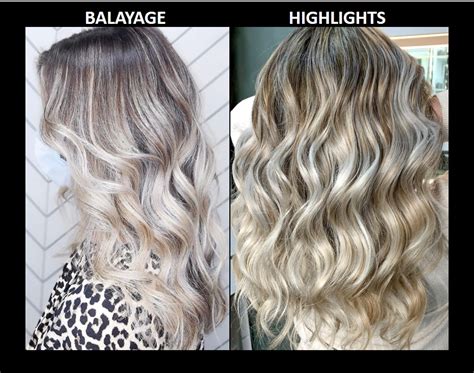What is Balayage?
Balayage is a French hair coloring technique that creates natural-looking, sun-kissed highlights. The word “balayage” means “to sweep” in French, and the technique involves painting color onto the hair in a sweeping motion, resulting in soft, blended highlights.

Balayage is particularly well-suited for dark hair because it creates dimension and depth without creating harsh lines or a stark contrast between the highlights and base color.
What are Highlights?
Highlights are a classic hair coloring technique that involves lightening strands of hair with bleach or color to create a more dramatic, noticeable effect. Highlights can be applied in various thicknesses and shades to achieve different looks, ranging from subtle to bold.
Traditional highlights are often placed in a regular, even pattern throughout the hair, while balayage highlights are typically more irregular and natural-looking.
Balayage vs Highlights: Key Differences
| Feature | Balayage | Highlights |
|---|---|---|
| Application Method | Painted in a sweeping motion | Applied in even sections |
| Result | Natural-looking, blended highlights | Dramatic, noticeable highlights |
| Suitability for Dark Hair | Excellent | Very good |
| Maintenance | Low | Medium |
| Trendiness | Very trendy | Classic |
Pros and Cons of Balayage
Pros:
- Natural-looking: Balayage creates subtle, blended highlights that mimic the natural effects of sun exposure.
- Low maintenance: Balayage highlights grow out gracefully, requiring less frequent touch-ups.
- Dimensional: Balayage adds depth and dimension to dark hair, creating a multi-dimensional look.
Cons:
- Time-consuming: Balayage can take longer to apply than traditional highlights.
- Cost: Balayage is generally more expensive than highlights.
Pros and Cons of Highlights
Pros:
- Dramatic: Highlights create a more noticeable, striking effect compared to balayage.
- Versatile: Highlights can be customized in thickness, shade, and placement to suit any style.
- Affordable: Highlights are generally less expensive than balayage.
Cons:
- Higher maintenance: Highlights require more frequent touch-ups to maintain their vibrancy.
- Harsh lines: Traditional highlights can sometimes create harsh lines between the highlights and base color.
Which Technique is Right for You?
The choice between balayage and highlights ultimately depends on your personal preferences and hair goals. If you desire a natural-looking, low-maintenance option, balayage is an excellent choice. If you prefer a more dramatic, eye-catching effect, highlights may be more suited to you.
Types of Balayage for Dark Hair
There are several types of balayage that are particularly flattering on dark hair:
- Soft Balayage: Creates subtle, soft-looking highlights that blend seamlessly with the base color.
- Caramel Balayage: Adds warm, caramel-colored highlights to dark hair, creating a rich, luxurious look.
- Bronde Balayage: Combines brown and blonde highlights to achieve a natural, sun-kissed effect.
- Rose Gold Balayage: Adds pink and gold tones to dark hair, resulting in a trendy, metallic look.
Types of Highlights for Dark Hair
Highlights can be customized to create various effects on dark hair:
- Traditional Highlights: Evenly spaced, traditional highlights create a bold, contrasting look.
- Chunky Highlights: Thicker, chunky highlights add a statement-making element to dark hair.
- Babylights: A technique that uses fine, delicate highlights to create a soft, natural effect.
- Lowlights: Darker highlights that add depth and dimension to dark hair.
Tips for Choosing the Right Color for Balayage or Highlights
- Skin tone: Warm skin tones look best with golden or caramel-colored highlights, while cool skin tones suit cooler tones like ash blonde or silver.
- Base hair color: Highlights and balayage should complement your natural hair color, not clash with it.
- Personal style: Consider your personal style and the desired effect you want to achieve when choosing a color.
Maintenance for Balayage and Highlights
- Shampoo and conditioner: Use sulfate-free products to preserve the color and prevent fading.
- Toning: Regular toning treatments can help maintain the vibrancy of your highlights or balayage.
- Touch-ups: Balayage typically requires less frequent touch-ups than highlights, but both techniques need periodic maintenance to stay fresh.
FAQs
1. Do I need to bleach my hair for balayage or highlights?
Yes, both balayage and highlights require bleach to lighten the hair and create the desired effect.
2. How often should I get balayage or highlights?
The frequency of touch-ups for balayage and highlights varies depending on the individual. Generally, touch-ups are recommended every 6-8 weeks for optimal results.
3. Can I do balayage or highlights at home?
While DIY balayage or highlights are possible, it is highly recommended to seek professional guidance to achieve the best results and avoid damage.
4. How much does balayage or highlights cost?
The cost of balayage or highlights varies depending on the salon, experience of the stylist, and the complexity of the desired look. Generally, balayage tends to be more expensive than highlights.
5. Which technique is easier to maintain?
Balayage is generally considered easier to maintain than highlights because the highlights grow out more naturally.
6. Which technique is more suitable for shorter hair?
Balayage is a better option for shorter hair because it allows for more precise application and creates a more natural-looking effect.
Conclusion
Both balayage and highlights are excellent choices for adding dimension and color to dark hair. The best technique for you depends on your personal preferences, hair goals, and lifestyle. By considering the factors discussed above, you can make an informed decision that will enhance your look and bring out your inner radiance.
